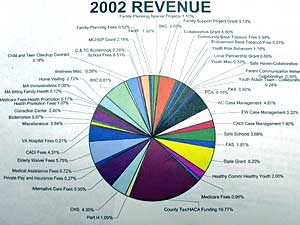|
Audio
Photos
Your Voice
|
Public health services are hurting
August 27, 2003
The effect of budget cuts continues to trickle down to communities across Minnesota. Public health administrators are worried about how they'll fulfill their mission with less money. They say some important prevention programs may be discarded.
Moorhead, Minn. — Brenda Menier says she's lost a lot of sleep the past few months. She had to lay of 20 employees this summer, and eliminate a home nursing program for the elderly.
Menier runs public health programs in Polk County. Her budget was cut by 10 percent, or about $200,000. As a result, tobacco, drug, and alcohol prevention programs for youth may be eliminated.
"It is frustrating, from someone who's been in public health for 20 years, to see the pendulum swing this far. I'd say it's a tragedy -- and one way or another we are going to pay for this," says Menier.
Public health programs in many counties are funded by a dizzying mix of government programs and foundation grants. A multicolored pie chart on Brenda Menier's desk shows 44 sources of funding for public health programs in Polk county. Menier says she doesn't consider any of those funding sources secure.
 | |||
"I would say that our infrastructure throughout the state is very fragile," says Menier. "I've shown you our funding streams, and it's like I've built a house of cards. It wouldn't take much of a wind to have it fall down."
The state of Minnesota has streamlined funding for public health. Eight separate grants were combined into one, and then the entire amount was cut by 29 percent.
Menier says state cuts will affect some of the other grants she gets, so the final effect of budget cuts is still unclear.
Liz Auch has identified a clear effect of budget cuts. Auch runs Countryside Public Health, which covers five western Minnesota counties. She says the agency stopped sending parents reminders about child immunizations.
"Ten months ago our immunization rates for 2-year-olds was 80 percent. Ten months later we're at 70 percent," says Auch. "That's a significant drop. Does anyone see that? Does anybody know that? No, but once we start seeing disease outbreaks people are going to go, how come we're seeing this?"
In addition to budget cuts, public health agencies are spending more time on homeland security. Counties are getting some federal funding for security for bioterrorism, but Liz Auch says it's not enough. Public health priorities are being shifted.
"You're starting to make choices of -- I guess we may have less kids up to date on immunizations, but we're very prepared for a bioterroristic threat," says Auch.
Each public health agency in the state is reacting differently to budget cuts. Clay County Public Health Administrator Betty Windom Kirsch is trying to protect programs she considers critical.
One of those programs is called Baby Steps, which is designed to help young mothers and babies get a good start.
|
You're starting to make choices of -- I guess we may have less kids up to date on immunizations, but we're very prepared for a bioterroristic threat.
- Liz Auch, director of Countryside Public Health |
Aveena Binave came to Moorhead from Iraq a few years ago. She's legally blind, but cares for two young children in a small apartment. Her husband is working as a U.S. military translator in Iraq.
Binave has been getting regular visits from a public health nurse through the Baby Steps program.
"I can't tell how much it is helpful, you know. I don't like it, I love it," says Binave. "I can't take my kids each time I have a question, I can't take them to the hospital. It costs a lot. This program is really helpful because you feel like your kids have support."
Betty Windom Kirsch is willing to sacrifice to save this program. She has to cut $250,000 from the Clay County public health budget. As a result, health inspection fees for restaurants and other businesses will increase sharply, and a variety of programs will be trimmed. So far, Kirsch has laid off three staff members and reduced hours for 18 others.
"The people that are probably going to be paying -- really, really paying for this budget cut -- are my staff. Because they're going to be going home with less income, and less benefits, but I'm still expecting us to produce core things that will be the same," says Kirsch. Kirsch fears public health workers will spend more time reacting to immediate needs and much less time on prevention.
That's also a concern for Minnesota Health Commissioner Diane Mandernach. She's pulling together a task force to look for ways to get more resources for prevention programs. She wants businesses and communities to get involved.
"It isn't only a burden on the health department. It's a burden on the entire community of how we come together and accept this -- understanding that it's in prevention we make the greatest impact on health," says Mandernach.
Diane Mandernach says Minnesota's ranking as one of the healthiest states in the nation is the result of a strong public health system. She says creative solutions are needed to maintain and strengthen that system when money is in short supply.
|
News Headlines
|
Related Subjects
|

